Executive summary
This report provides is a detailed study on the provision of services in the UAE public sector. The study focuses on determining the best strategies to use to address the problems related to the provision of services on the public sector in the UAE and seeks to find out the best methods to use to provide good quality services. In the report, it is a hypothesis was formulated to answer the questions on the use of the EFQM excellence model and the Total Quality Management philosophy (TQM) as the most appropriate method of improving the quality of services based on the quality of service model. The study used both qualitative and quantitative research paradigms to make sure that the paper gained from the use of the combination of both methods to discover if the models provide the solution to the quality related issues. Interviews and questionnaires formed the fundamental elements of the research paper and several issues were discovered. At the management and departmental levels, it was realised that the public services lacks a comprehensive model for quality assurance and quality control to enable the customers to access good quality services. It was realised in the study that integrating the EFQM business excellence model could provide the management of the public service and leadership required to implement the TQM philosophical quality initiatives to ensure that the employees were educated on service quality initiatives based on the service quality model. On the other hand, the questionnaires were used to answer the research question on various other components of the EFQM model and the TQM initiatives and yielded a lot of valuable information on best strategies to use to address poor service delivery in the public sector. The suggestions included providing leadership based on the EFQM models to educate employees on the service quality elements such as service quality performance, service quality productivity, and quality gaps. In addition, it was realised that the EFQM provided the framework for educating the workers on the service quality provision, which have outcomes which are customer and people focused. The service quality model could be used to provide the framework for employee training and self assessment and continuous quality improvement, a function of the TQM initiative.
Introduction
Integrating the European Foundation for Quality Management (EFQM) excellence model with Total Quality Management (TQM) initiatives for public sector employees for continuous improvement of the quality is one of the critical approaches public sector employees use to achieve excellence in service provision in the public sector. In addition, the paper will provide the basis for the researcher to develop skill in skills in excellence on service delivery in the public sector (Bryman, 2012).
Most of the services offered by the public sector employees do not meet the quality standards prescribed by international standards such as the ISO 9000. The underpinning reason is that employees in the public sector lack appropriate total quality management practices to ensure the employees work and provide the public with good quality services.
The problem
The delivery quality of services delivered by the public service employees has raised many complaints from the people. A close investigation shows a gap in literature, which provides the foundation for continuous improvement of the quality of services provided by the public service employees based on the EFQM excellence models using the TQM initiatives for continuous improvement. The proposed solution is to provide the public sector management with TQM initiatives for quality continuous quality improvement of the services provided by public service employees to the public.
The ultimate goal is to enable the public sector employees provide better quality services based on the EFQM models and the total quality management framework. The public and the employees will benefit because employees will be able to provide the public with good quality services and the employees will learn to continuously improve on the quality of services they provides to the public (Fotopoulos & Psomas, 2010).
Research questions
Does integrating the total quality management initiatives into the EFQM model provide employees with the ability to offer better quality services? How could public sector employees use TQM initiatives based on the EFQM excellence model to improve the quality of services they provide to the public? What business excellence elements of the EFQM model can be factored to create the framework for TQM initiatives?
Research approach
The approach to use to conduct the study includes:
- I will conduct a literature review of EFQM businesses excellence and TQM initiatives for continuous improvement.
- I will seek for permission to collect data from the public sector employees on their perceptions on the EFQM business excellence model and t=TQM initiatives for continuous improvements.
- I will conduct an interview with the departmental heads on the quality of services offered by the public service employees.
- I will anayse the resulting data to determine the best approach to integrate the EFQM business excellence model and TQM initiatives to provide an excellent model for the provision of quality services.
Limitations
Access to information on the problems associated with the provision of public services by the public service employees because of fear of being victimized.
About the public service
The public service of the UAE is mandated to provide good quality services to the people of the UAE. Many people in the public are expecting the delivery of good quality services by the public sector workers. To achieve the goal of better service delivery, the government, through its departmental heads has realised the need to implement a service quality program to improve on the delivery of services to the public. Based on the quality expectations of the public and the need for the government to become quality centric has necessitated the need to assess for the best methods to provide good quality services. The government and concerned stakeholder understand the cost savings, and the quality of life, which could result from the provision of good quality services for the public. The government and departmental heads have realised that the use of the EFQM excellence model provides a leadership framework for the implementation of the TQM initiatives for continuous improvements in the quality of services being offered in the public sector. The demand for good quality services is people driven and is bound to create public value. Public value creates positive perceptions form the public, increases the level of trust on the public, and leads to efficiency on savings based on service quality model. By educating the public service employees on good quality initiatives, they are able to increase their productivity, reduces the time it takes for a service to be delivered, simplifies procedures for doing a task, and increases productivity and efficiency in the public service.
The rationale for the study is that the public service has been experiencing a significant rise in the number of customers complaining about the quality of services being delivered. The customers’ complaints include the long response time the public service workers take to address their problems, the poor responses they from the workers, and lack of apathy in their side. Those reasons underpin the reasons for conducting the study to discover the best service quality delivery method in the UAE to address the needs of the public.
Literature Review
The idea
The ideas is to use the EFQM excellence model by integrating it with the TQM initiatives to provide the best framework for training employees in the public sector in the UAE on how to improve the quality of services they offer to the public. The models provide the framework for educating the management on their leadership initiatives to act as the drives of change in the provision of good services. The provision of services will be based on the TQM initiatives, the EFQM excellence model and the service quality model to provide a holistic approach to service delivery.
Step one
The first step is to study the models without involving the participants, who are the public service employees and the public service administrators at different level of government. The sty will focus on the how the EFQM model provides the framework for leadership to act as the drive of change in the public sector.
Step two
Step two will include the study of the TQM mode initiatives for continuous improvements and how it translates to high quality service delivery.
Step three
Step three is where the tow models will be combined with the service quality model to provide the best guidelines for training workers in the public sector on various service quality elements including apathy and responsiveness among others and how they contribute to service quality improvements.
Step four
The fourth step is where theory and practice meet to strike a balance on the best approach to use to train workers on service quality. The results from the study will be combined with the results from the field to provide the best strategies for service quality improvement in the public sector.
The literature review will cover issues related EFQM excellence model and TQM initiatives in continuous improvement in the provision of services in the public sector in the UAE (Weishaupt, 2010). TQM is a model that provides the framework for individual development. The methodology and research plan includes studying the literature on TQM, which is a tool for technical and social dimensions in the provision of good quality services. The model, which factors the elements of EFQM excellence model, provides the elements, which the management and the employee can use to improve the quality of service being offered in the public sector (Santouridis & Trivellas, 2010). The quality of service is perceived in the form of customer perceptions and satisfaction, the quality of services within the public service are improved and made of good quality. Statistical data is made available using quantitative data to manage and reduce variations in the quality of series offered (Santouridis & Trivellas, 2010). The literature will focus on adopting different performance related standards to ensure continuous improvement of public service activities based on the TQM initiatives as shown in the diagram below.
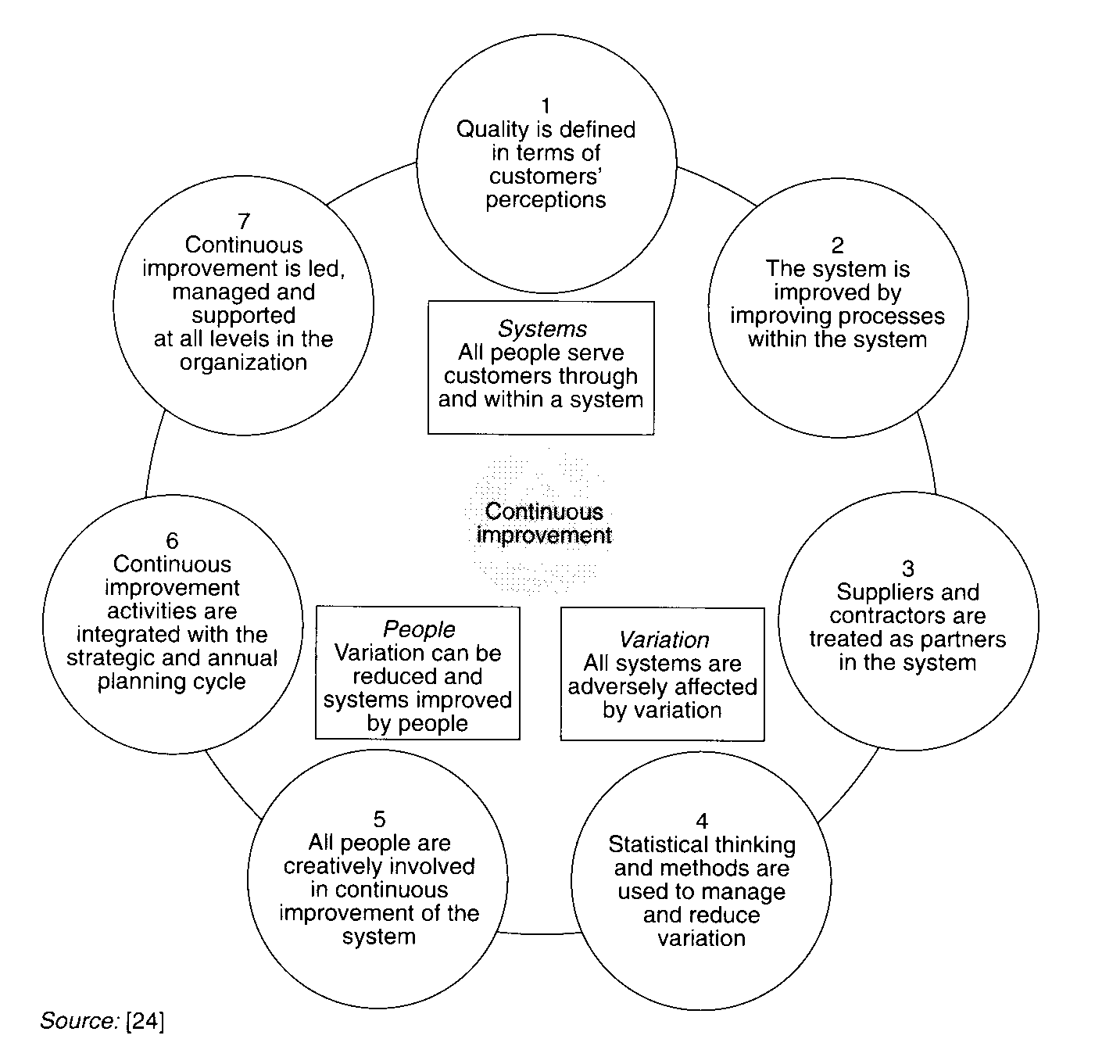
The literature will provide a framework for the self improvement using TQM initiatives in the EFQM excellence model as shown below.
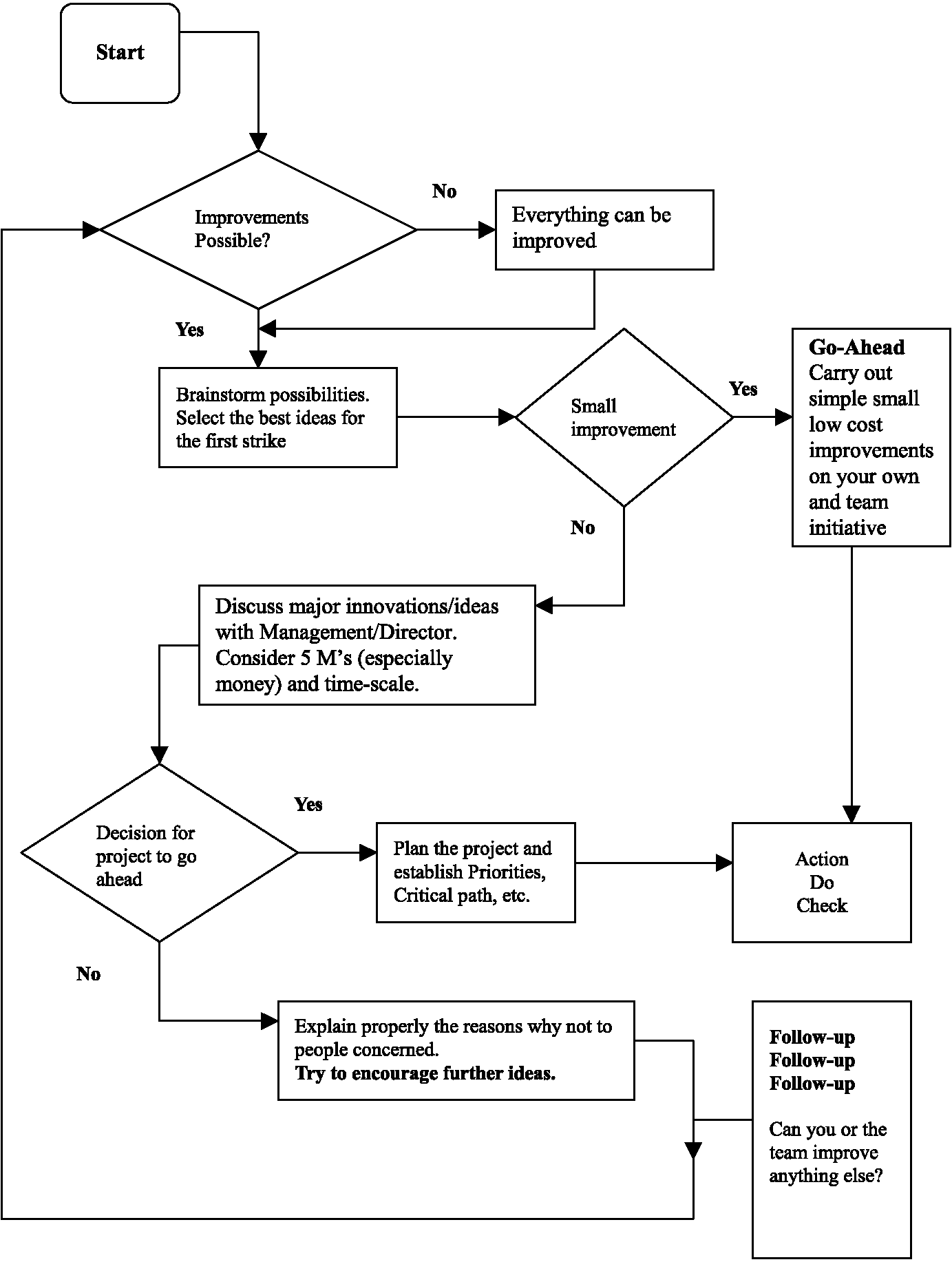
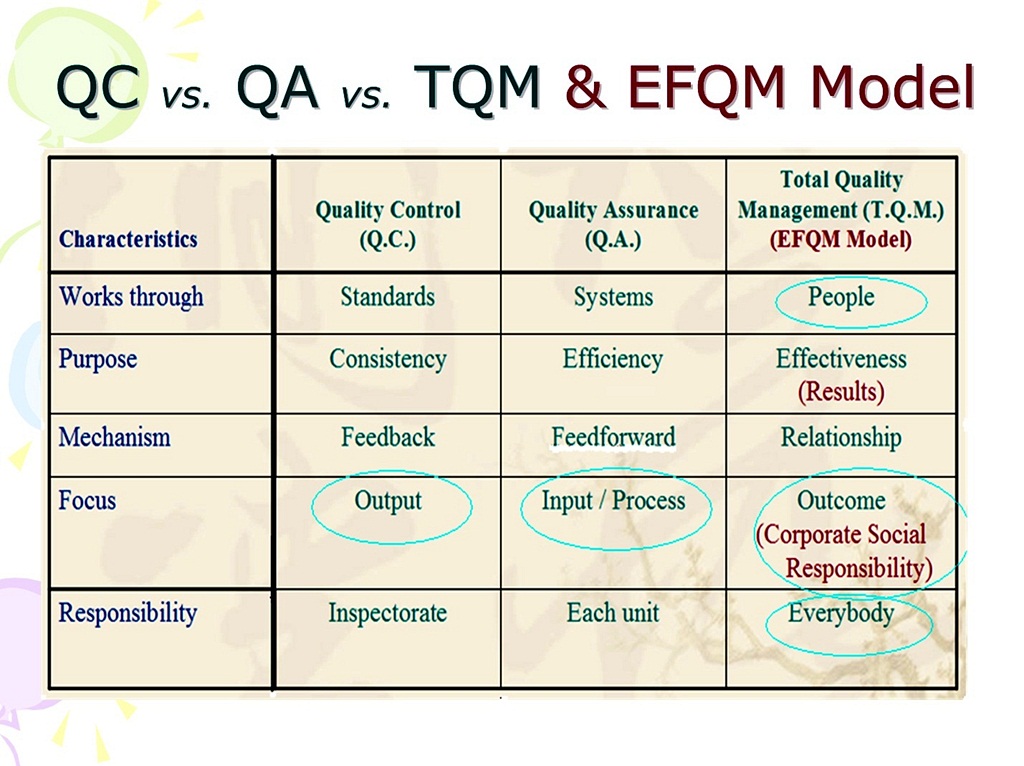
Approach
The research methods to use are both qualitative and quantitative research methods. Qualitative research methods will be combined to provide a mixed research method to overcome the weaknesses of each research method. The quantitative paradigm will provide the researcher with numerical data, which will be analysed to provide numerical answers to the research questions on the problems associated with the provision of public services by the public service employees in the UAE. Each paradigm will provide the research with its advantages. The quantitative paradigm provides the researcher with the ability to numerically evaluate the response from the public and the employees on their problems in relation to service delivery and quality issues.
The overall research method is the mixed research method. A mixed research method is a combination of qualitative and quantitative research paradigms. The approach provides the research with the benefits of using both total quality management to and the EFQM business excellence model to justify the theoretical basis on which the quality paradigms are based. In addition, the research paradigm allows the research to explain the knowledge claim on the use of total quality management as a paradigm for continuous improvements in offering public services. In addition, the mixed research methods provide the research with the best strategic approach of inquiring on the effects of the total quality management elements and the EFQM excellence business model on the best methods to provide services to the public (Mertens, 2009).
Research plan
The research design will provide the research with the way in which the research will be done to reach the research objectives by identifying the variables which include the elements of the EFQM model and the concepts of the total quality management. TQM and EFQM are to independent variables and the perceptions of the public in terms of the services they are provided with are dependent variables. Other variables in the research processes include the intervening variables, which include the continuous quality improvement and other variables which will be determined in the study.
Hypothesis
The hypothesis is a statement which shows the relationship between the quality of public services and the elements of TQM initiatives based on the EFQM business excellence model. The hypothesis in this research is that, lack of TQM initiatives for continuous quality improvements based on the EFQM excellence model is the reason for the poor service delivery in the public sector in the UAE. The hypothesis is that improving the provision of services in the public sector based on total quality management initiatives and the EFQM excellence model will improve the quality of services provided by the public service employees.
Purpose of the study
The study will focus on the discovering how the quality of services can be improved in the UAE by ensuring that employees are subjected to the total quality management initiatives and the EFQM excellence model. Data collection will be done to discover the level of dissatisfaction of the public who have been subjected to the services in the public sector. Data collection will be done to determine accurate answers to the research questions on how the total quality management initiatives and EFQM excellence model will contribute to the provision of quality services for the customers and for the improvement of the services offered by the public service employees. The research methods, which include qualitative and quantitative paradigms provides the basis for combining both paradigms to conduct the required study (Olaru, Dinu, Stoleriu, Sandru & Dincă, 2010).
The mixed research method will provide the researcher with the use of sequential methods to expand on the findings of the elements, which contribute to the provision of good quality services. The mixed approach will begin with the use of the qualitative paradigm where the researcher will explore how total quality management initiatives will lead to continuous improvement in the delivery of services to the customers. The method will enable the researcher to understand the sources of the problems associated with the poor provision of services and how the employees can improve o service provision. The qualitative research paradigms provide the researcher with the ability to use different elements such as the ones shown in the diagram below to understand the best methods as shown in the table below.
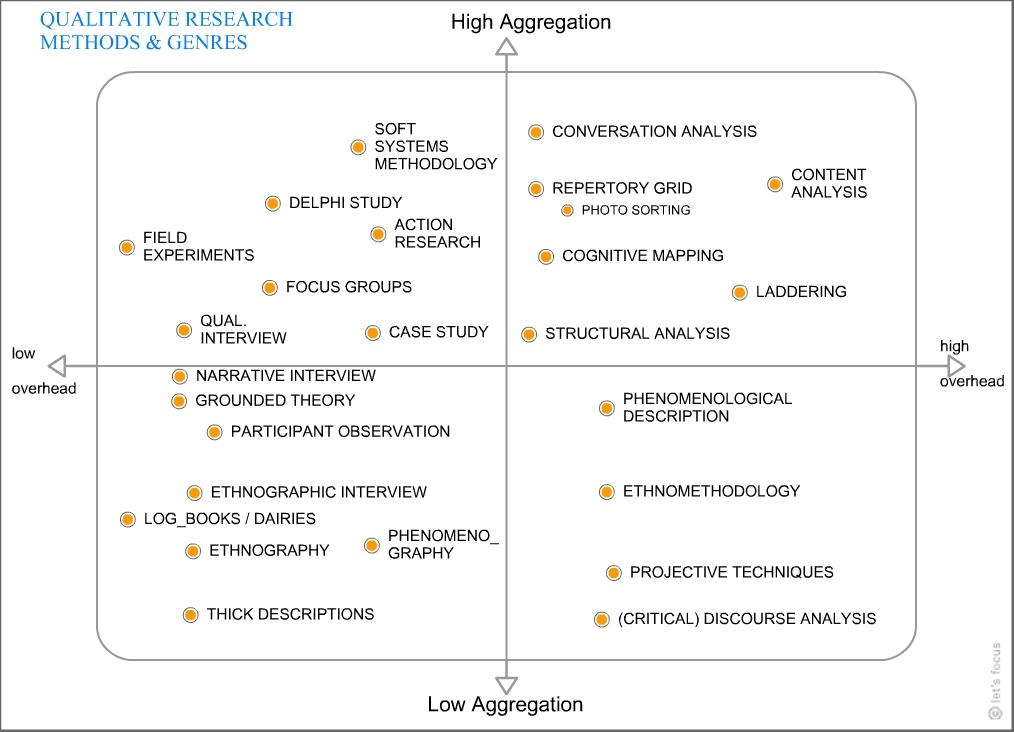
On the other hand the quantitative paradigm provides the researcher with the ability to collect to ensure that appropriate data is used to clean data about that is used for the purpose of identifying the problem of poor service delivery by the public employees. In addition, it provides the researcher with the ability to stretch data across different situation in service delivery. It has been established that the paradigm enables the researcher to discover missing data which can be used for the research.
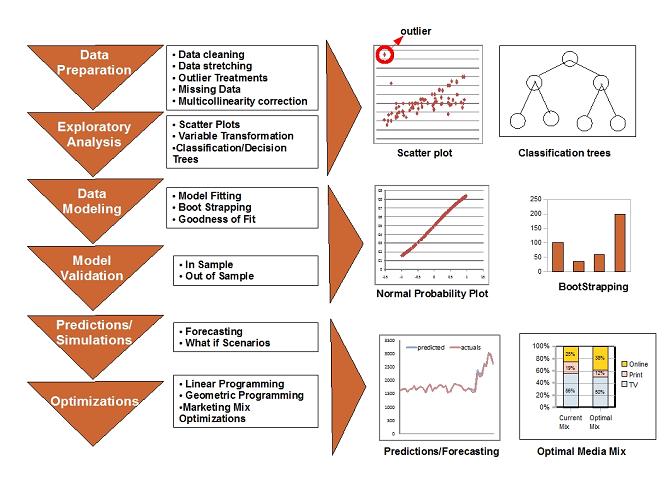
In conclusion, the paradigm provides the researcher with the ability to develop to integrate concurrent procedures to comprehensively address the research problem. Here, a theoretical approach is used to combine both qualitative and quantitative paradigms.
Design of the study
Sampling strategy
The sampling approach to use is the stratified sampling method. The method provides the researcher with the ability to develop a sample design which is appropriate for use and representative of the entire population. The population here is the number of people working as public service employees and the public as a whole who benefit from the services provided by the employees. In addition, the entire population cannot be used in the study as it will be big and difficult to anayse. To select a representative sample of the population, the stratified sampling method will be used. A representative sample is simply part of the population, which has the characteristics of the population. The stratified sampling method will be the most appropriate because it provides an accurate representation of the population to be researched. The strategy is useful because the population can be exhaustively partitioned into disjoint groups. In addition, the stratified sampling method is appropriate for large samples and is suitable for the current study because it will cover public service employees.
Verifiable identification
Verification deals with the truthfulness of the facts which are collected for the research purpose. Different elements will be defined in the verification and validation schemes as shown below. Here, the validation and verification will be done according to regression, system, and beta tests. Verification will include style checks, proof of correctness, consistency checking, static analysis, and code inspection checks. On the other hand, the validation will include goal analysis, model inspection, and prototyping.
Data
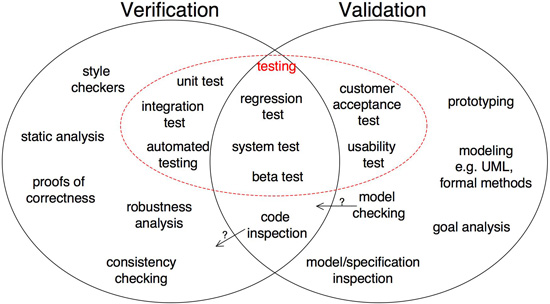
Data Collection
The data collection methods include using primary and secondary sources. Primary sources of data include actual data that is collected from the participants in the research. Secondary sources include literature on the performance of employees in terms of service delivery in the public sector. In addition, literature reviews will provide additional sources of data for the study.
Data collection instruments
To ensure that the data is of good quality and meets the standard requirements for data collection for research purposes, different data collection instruments will be used. One of the tools to use is a questionnaire. Questionnaires can either be open or closed ended. Closed ended questionnaires will be administered to provide the researcher with quantitative data, which will be analyzed statistically to provide the researcher with the required numerical figures for decision making. On the other hand, the closed ended questionnaires will be administered to the public and the participants will be given the opportunity to express their feelings about certain issues. On the other hand, interviews will be used to collect qualitative data, which is part of an effective instrument used in social research. The interview tool is effective because people are able to express their problems and immediately suggest solutions to the problems.
Sample Data
The sample data that was used in the study is shown below.
Research ethics
Data gathering is the critical step in the study because it involves human subjects, with whom the researcher gets to interact with. Typically, the behavior of the subjects and their attitude towards the research activity of collecting data, which is private and confidential, requires that the level of interaction between the researcher and the respondents be established in accordance with research ethics. Ethics is about the values and beliefs about individuals and the fundamental principles surrounding the approach used to collect data from individuals. Ethics becomes very important when using conducting interviews because it guides the researcher on the best methods to use to interact with the subjects. The researcher will consider a number of issues in the study to utilize the people as respondents and as sources of data in the research. The primary concern is for the safety of the researcher and the respondent, who use and provide the required data respectively, which might be sensitive for the research. Here, the researcher has to adhere to the ethical norms of the research. Ethical norms deal with the truthfulness of the research to avoid introducing errors or using invalid data.
The codes and policies of ethical research underpin the current study. One of the norms is to be honest. The research procedure, publication status and other forms of research data should not be fabricated. There is need to ensure the objectivity of the research in collecting and analysing data in the performance of public service employees in the UAE. It is important for the researcher to strive for the integrity of the results because it deals with the sensitive data and responses from the public. Other issues to be factored include openness, non-discrimination, and respect for participants, social responsibility, confidentiality, responsible publication, and the ethical code of conduct.
No respondents will be forced to provide data or participate in the study. To ensure that the participation process is free and voluntary, the participants will not be compelled o participate and each respondent will be required to sign a form to ensure that their participation is voluntary.
The research will be conducted by adhering to the ethical principles, which include autonomy, beneficence, which is based on the obligation of the investigator, justice for the researcher and the principle. The other principle to adhere to is human justice to ensure equal participation of the participants. To ensure that the research is ethically valid a number of components have to be present. Those components include understanding, disclosure, competence, consent, confidentiality, voluntariness, and understanding for both the researcher and the subjects.
Limitations
The study will be limited to the factors which contribute to the poor performance of public service employees and how the EFQM excellence model underpins the implementation of TQM initiatives to improve the delivery of public services.
Analysis
Analysis in this study will provide the basis for validating the data to determine its relevance to the study. In addition, analysis will provide answers to the research question and be able to verify the research hypothesis on the use of EFQM excellence model on TQM initiatives to improve the quality of public service delivery to the public. The hypothesis provides the ground for investigating the problems and how to correlate the findings to enable the public service employees improve the quality of services based on the key elements of the EFQM and TQM models for continuous improvements.
Data analysis and hypothesis testing
Statistical tools which include the SPSS will be used after the data has been assessed for validity and consistence. The data t be used will have to be error free to ensure the results are correct and consistent. The quality of data has to be maintained to ensure the consistence with data quality requirements, Those requirements include timeliness, consistency, accuracy, completeness to avoid problems, which include incompleteness, context dependent, incompleteness, and immeasurable. The data quality process is summarized in the diagram below.
To ensure the quality of data is as required, the data, the data will be checked for missing attributes, missing values, and the use of the correct truncation mechanism to ensure data quality.
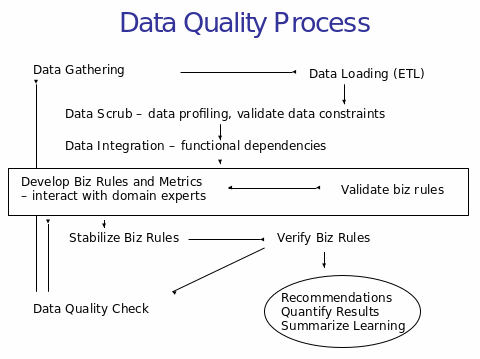
Results
The results of the study are discusses below.
Interview
The interview involved heads of department, employees, and the public on the quality of service delivery. Different departmental heads were interviewed, based on a qualitative research design, which is a social research technique to answer the questions on the quality of services delivered and the quality standards used by the departments to measure the quality of services being offered. During the interview, it was determined that the departments do not have quality standards against, which the quality of services offered by the employees in each of the departments were measured. It was noted that the departments do not have a quality continuous quality improvements to ensure that employees always work toward continuous improvement of services. The interview was taken to different departmental heads and the problem quality improvements were noted to be across the departments. The rationale was to improve the quality of services to the employees. It was further established that the departmental heads have not integrated the EFQM business excellence model in the provision of services and neither are the two models integrated on the quality of service delivery.
The departmental heads suggested that integrating the aspects of EFM business excellence model with the TQM model initiatives could provide the employees with the ability to provide good quality services for the customers. The departmental heads agreed that the EFQM model and the TQM initiatives provide the employees and the departmental heads with the ability to plan for the quality initiatives and develop services that meet customer needs. Once the plan is over, the implementation process of the model begins. The implementation process includes providing high quality reliable services to the customers. According to the TQM model, the customers are the point of focus and the need for continuous improvement by the service providers, who are the workers. Here, employee involvement and continuous improvements underpin the quality of services offered to the customers. According to the EFQM model, the enablers of quality are departmental heads and workers. To ensure the services are reliable, the departmental heads have accepted to work with the employees by performing their services to the customers dependably and by ensuing that the customers get satisfied with the type of services they provide. Each customer is supposed to receive due attention the moment they enter into any office according to the requirements of the customer. In addition, any problems associated with the provision of quality services to the customer are addressed immediately. Customer complaints receive immediate attention from the head of department and the workers. If a problem needs to be escalated, it is processed and taken to the head of the department or others high in the hierarchy.
The management agreed that the people, policy, and strategy are the critical elements, which can be combined with the TQM initiatives of continuous improvements to ensure the quality if services. The management agreed that by integrating the quality of service model, the public service is able to provide good quality services. Results from the interview showed that the dimensions of quality included responsiveness, which is defined by the need to help customers as required and immediately. By integrating the EFQM model elements, which are people driven with the TQM model elements, which include communication, which is process centered provides the desired good quality services to the customers. The services are therefore defined by assurance, which makes the customer to feel assured about the services and responses they receive from the workers. If a customer comes with a problem that requires urgent attention, the worker has to assure the customer that the problem will be accorded the required attention to meet the quality standards defined in the new model.
The results from the interview showed that the management and the employees need to show empathy in the provision of services to the customers. It is important for the management and the workers to be easily approachable when offering services to ensure that they can easily get in touch with the people and take their problems as their own. Such feelings of empathy are critical in the development of the knowledge of the workers in the provision of services. The management recognises the need to use the quality service model as part of the strategic processes of improving the quality of services. Some other aspects of service quality were not discussed because of time and the next tool to analyse was the questionnaire.
Questionnaires
An analysis of the questionnaire showed a number of responses on the provision of the quality of services. Here, the respondents showed a high degree of response and the tool showed a significant level of support for the need for workers and the management to offer good quality services. Results showed that the elements of the EFQM excellence model required the departmental heads to provide leadership in the provision of high quality services. Once the management and the departmental heads and workers set the direction and the strategic process of quality service provision, the strategy should lead to people, customer, and society results. Here, the people results are based on customer satisfaction.
To ensure the provision of quality services, the TQM model initiatives provides employees with the elements, which drive them to the need to close the service quality gaps in the departments to ensure that the workers show the sense of continuous quality improvement. The underlying rationale is to provide the customers with the good quality services by bridging the quality gap in knowledge of the workers. Bridging the quality gap implies educating the workers on what is expected of them and their conduct towards the customers. The workers need to be educated on what is expected of them, and the management has to specify the standards that the workers have to comply with to ensure good quality service delivery. The recommended standard here is the ISO 9000 series of quality standard, which provides guidelines on the provision of good quality services. According to the TQM initiatives, continuous improvements is based on internal communication to ensure that the performance of the employees is aligned to the ISO 9000 series of quality standards, the service quality model, and the EFQM business model. Here, perceived services and expected services are bridged by the use of the elements of the different models integrated together. The remaining model is based on the diagram shown below.
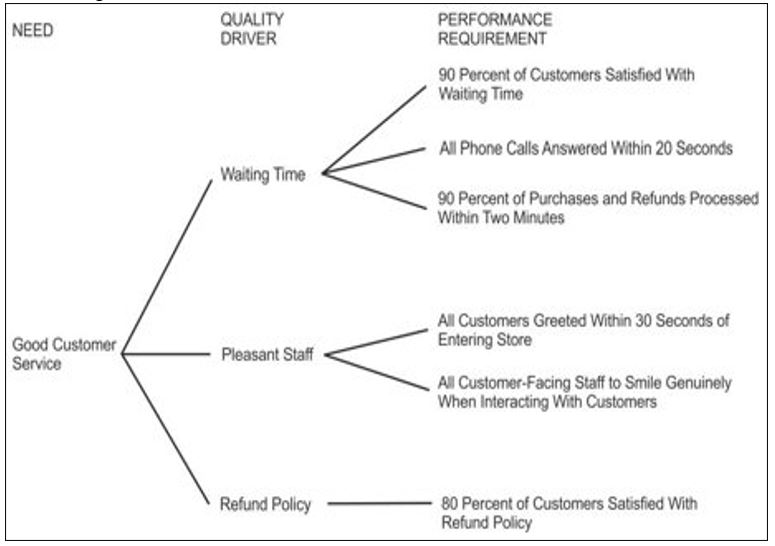
The question questionnaire report provides the management with the strategic approaches to ensure that the services offered o the customer is of good quality. The end point is the customer and the point of focus in this quality issue. Here, the service provided to the customers is defined by a number of elements, which include the waiting time for a service to be delivered. According to the results on the questionnaire, it was established that the management and the departmental heads responded by agreeing that the waiting time for a service was too long. A significant number of customers agreed that when they went into the office, they realised that the customer waiting time was a hindrance to the provision of good quality services. The rationale was to discover the right time to execute a task to ensure the services were of good quality. The departmental heads and the management of the public services agreed that the provision of good public services influenced the perceptions of the customers toward the management and the public service as a whole.
It was critical for the management and the public service employees to work on a policy development program which focuses on team work and team development for the workers to work as a team to provide good quality services. Team work depends on team dynamics and team development goals, to ensure and enable the employees to work as a team in the provision of public services. The policy also provided direction to the head of departments to ensure that the workers use measures to ensure the quality of services is compliant with the standard requirements on quality.
The management was able to identify the real benefits of investing in quality initiatives in the provision of services to ensure that the customers get the best out of the services being offered to improve the image of the public services. The management agreed that the provision of quality services should be viewed as an investment, which has its own returns. Typically, the management agreed that there is a return on investment (ROI) known as quality return on investment on quality based on a number of assumptions which include viewing quality as an investment and that the elements of quality should translate to monetary value. The management agreed that they the cost of investing in quality is justified. However, it was agreed that not all expenditure on quality were justified and recommended that each department work towards valid expenditures. It is possible that the quality improvement program can be implemented to benefit the customers by implementing productivity improvement programs.
The whole process is conceptualized as shown below.
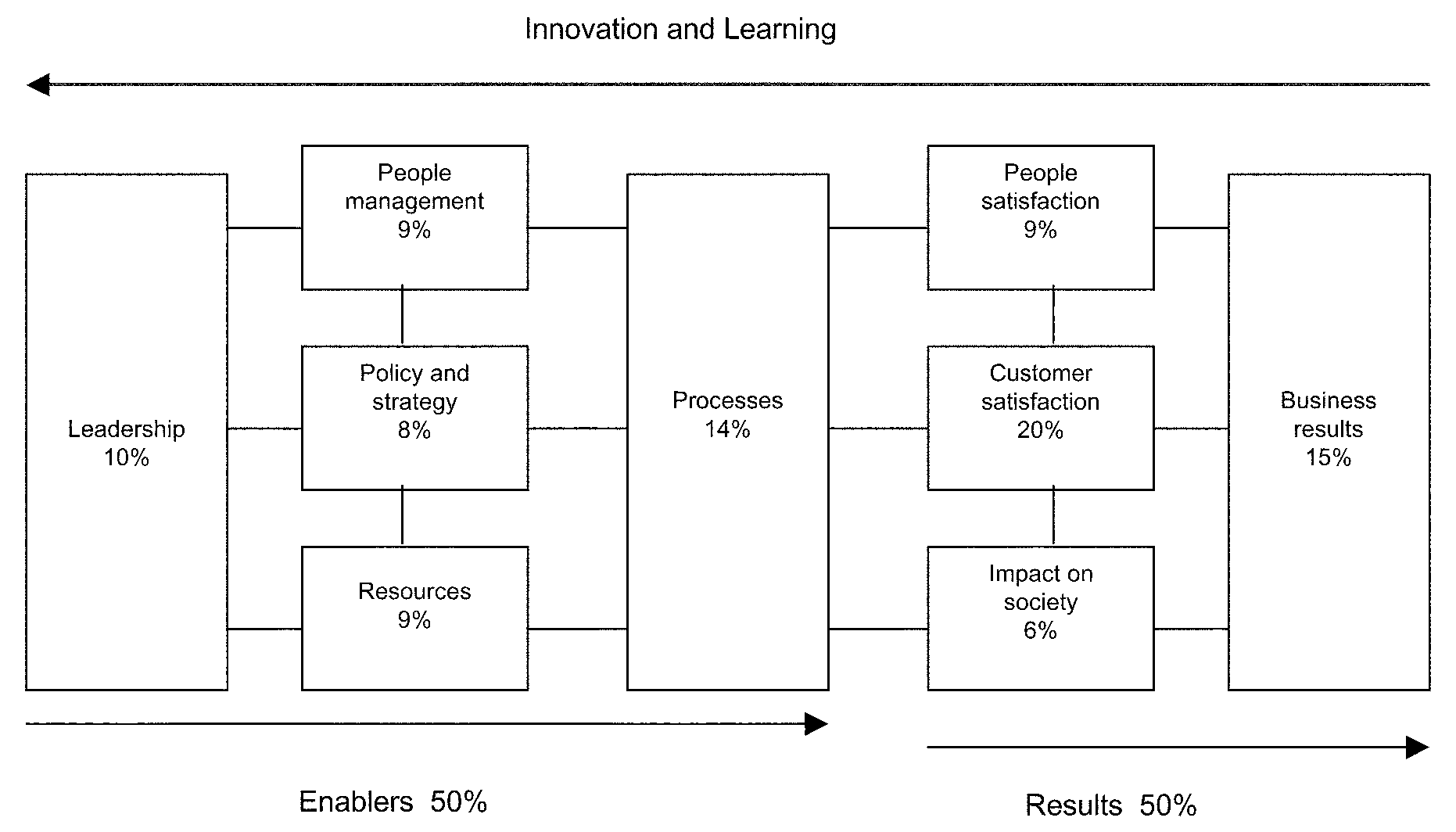
The manager agreed that the productivity concept can be implemented along with the total quality management paradigm and the EFQM model of business excellence. Here, service productivity is measures in terms of the amount of inputs in terms of the problem to be solved and the output to be provided in terms of what to be provided. When both concepts are integrated with the EFQM concept used to provide the strategic direction and leadership to provide quality improvement services in the productivity in the service context, the ratio of inputs and outputs define the level of service quality. It is difficult to provide numerical values of the service provision elements in relation to the productivity. In addition, the questionnaire provided information about the need to use the TQM and EFQM model to improve the level of excellence and efficiency in services provision. Here, effectiveness in the quality of services being offered in the public sector is defined as the degree and extent to which the management of the public service provides services. Here, the management agrees that the quality models provide the foundation upon which the public service sector has to work towards meeting the service provision goals. The goals are set and determined by the management and other public service leaders. The results have to be people based on the TQM and EFQM models.
Relationship between findings and issue being investigated
The point at, which theory, concepts, and practice meet to strike a balance on what should be adopted and translated into practice, enables the public service workers to develop a strategic plan on service quality improvement. The research explored the literature on various issues related to the quality of services provided by public service employees based on the theories of service quality, total quality management as a philosophy for service improvement and EFQM service excellence model. The theories and concepts combined provide a framework on, which to compare what has been established through interviews and questionnaires.
It was established that the interview data provided the management and the workers with the correct information on the right combination of the theoretical models of TQM and EFQM to improve the quality of services being provided. Here, theory views TQM as a philosophy on continuous quality improvement and EFQM is a model on the business excellence and service improvement. According to the interview report, the management provided a solid foundation by agreeing that there was a problem within the service provision and the need t use different models to address the quality of services being provided by the public service employees. A clear cut comparison shows that the management do not have any quality improvement model in place, neither are employees trained on the service quality models. For example, a worker who was interviewed agreed that they do not have a quality performance standard to measure the quality of services being offered. The employee agreed that implementing a quality management program could provide quality of services. There is a significant difference between the definition of quality and the model definition of quality. Here, the contexts of both the model and the employees have divergent approaches to service quality provision. In addition, the interview data provided the management with the right information on how and on what to train employee on the provision of good quality services. It was agreed that the EFQM model provides the leadership elements for the employees and the management to develop a model, which could provide a framework for the provision of quality services in the public service. Once the strategic leadership and direction is provided by the use of the EFQM model, the TQM initiatives of continuous improvement on the service quality model to ensure the quality of services are appropriate.
Conclusion
It has been demonstrated in the study that the public in the UAE need service quality that meets their needs and expectations. However, evidence from the study shows that the quality of services is poor, which is the direct result of the lack of a service quality mode or standards for workers to adhere to when delivering public services. To address the problems, the study proposed the use of the EFQM business excellence model as the best framework, which provides the public service departments head and the government officers with the leadership required to train workers on service quality practices to ensure continuous improvements in their knowledge on good quality service provision. The underpinning model is the total quality management initiatives, which is a philosophy on continuous improvements. The expected outcomes include high productivity, better quality service delivery, efficiency in service delivery, reduced waiting time for service delivery, good customer and service provider relationships, employee apathy, and improved service quality productivity.
Future Plan
My future plan concerning this area of study is to apply the principles of total quality management in the provision of services, which are designed to meet the specific needs of the customers. Here, the standard gap to be filled using the TQM model initiatives, the EFQM model of excellence, and the ISO 1900 standard will provide the basis for my future tasks. Educating workers to be knowledgeable about the gap in the delivery of services and requirements for the management to implement the quality education through recognition, leadership, teamwork, training, communication, and integrity of services, will underpin my future plan.
References
Bryman, A. (2012). Social research methods. Brooklyn, NY: Oxford university press.
Feilzer, M. Y. (2010). Doing mixed methods research pragmatically: Implications for the rediscovery of pragmatism as a research paradigm. Journal of mixed methods research, 4(1), 6-16.
Fotopoulos, C. V., & Psomas, E. L. (2010). The structural relationships between TQM factors and organizational performance. The TQM Journal, 22(5), 539-552.
Mertens, D. M. (2009). Research and evaluation in education and psychology: Integrating diversity with quantitative, qualitative, and mixed methods. Brooklyn, NY:Sage.
Olaru, M., Dinu, V., Stoleriu, G., Sandru, D., & Dincă, V. (2010). Responsible commercial activity of SMEs and specific values of sustainable development in terms of the European excellence model. Amfiteatru Economic, 12(27), 10-26.
Santouridis, I., & Trivellas, P. (2010). Investigating the impact of service quality and customer satisfaction on customer loyalty in mobile telephony in Greece. The TQM Journal, 22(3), 330-343.
Weishaupt, J. T. (2010). A silent revolution? New management ideas and the reinvention of European public employment services. Socio-Economic Review, 8(3), 461-486.